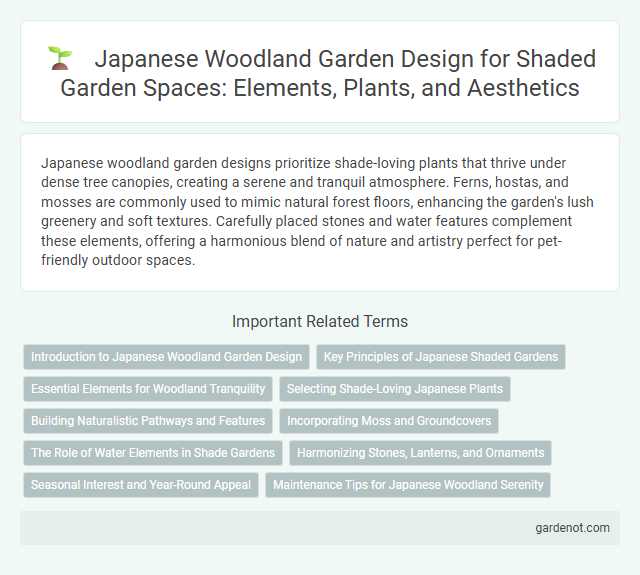Japanese woodland garden designs prioritize shade-loving plants that thrive under dense tree canopies, creating a serene and tranquil atmosphere. Ferns, hostas, and mosses are commonly used to mimic natural forest floors, enhancing the garden's lush greenery and soft textures. Carefully placed stones and water features complement these elements, offering a harmonious blend of nature and artistry perfect for pet-friendly outdoor spaces.
Introduction to Japanese Woodland Garden Design
Japanese woodland garden design emphasizes natural harmony by integrating native trees, moss, and shaded water features to create serene, contemplative spaces. This style thrives in shaded areas, utilizing dappled light and layered plantings such as ferns, hostas, and maples to mimic forest understories. Key elements include asymmetry, simplicity, and the balance of organic shapes to evoke tranquility and connection with nature.
Key Principles of Japanese Shaded Gardens
Japanese shaded gardens emphasize harmony with nature, using dappled sunlight to create serene, tranquil spaces. Key principles include the careful arrangement of moss, ferns, and shade-tolerant plants like hostas, complemented by natural stone pathways and water features. The design focuses on balance, simplicity, and the subtle interplay of light and shadow to evoke a meditative atmosphere.
Essential Elements for Woodland Tranquility
Japanese woodland gardens emphasize naturalistic design, incorporating moss-covered stones, layered plantings of ferns, and intermittent streams to evoke serenity. Essential elements include asymmetrical layout, the use of native shade-tolerant species like hostas and azaleas, and carefully placed bamboo or wooden structures that blend seamlessly with the forest environment. The interplay of dappled light and texture, combined with minimalist pathways, enhances the tranquil ambiance inherent to traditional Japanese woodland gardens.
Selecting Shade-Loving Japanese Plants
Selecting shade-loving Japanese plants is essential for creating an authentic woodland garden that thrives under dappled sunlight. Species such as hostas, ferns, Japanese forest grass (Hakonechloa macra), and shade-tolerant Japanese maples (Acer palmatum) provide lush textures and vibrant foliage in low-light conditions. Incorporating these plants ensures a serene, natural aesthetic while supporting biodiversity and soil health in shaded garden areas.
Building Naturalistic Pathways and Features
Japanese woodland gardens emphasize creating naturalistic pathways using uneven stones, moss, and compacted earth to blend seamlessly with the surrounding flora. Incorporating features such as winding trails, stepping stones, and subtle water elements enhances the garden's tranquil ambiance while guiding visitors through diverse plantings. Strategic placement of lanterns, bridges, and native shrubs further complements the organic feel, fostering a harmonious connection with nature.
Incorporating Moss and Groundcovers
In Japanese woodland gardens, incorporating moss and groundcovers enhances the tranquil, naturalistic ambiance by creating a lush, green carpet that thrives in shaded areas. Moss varieties such as sphagnum and icuzen form soft, vibrant mats that retain moisture and provide texture contrast against rocks and tree trunks. Low-growing groundcovers like ajuga and sweet woodruff complement moss by filling gaps and suppressing weeds, ensuring a harmonious, serene garden floor.
The Role of Water Elements in Shade Gardens
Water elements in Japanese woodland shade gardens create tranquil soundscapes that enhance the serene atmosphere and mimic natural forest streams. Incorporating features like koi ponds, bamboo water spouts (shishi-odoshi), or stone basins (tsukubai) promotes mindfulness and deepens the sensory experience. These water elements also support local biodiversity by attracting birds and amphibians, essential for maintaining ecological balance in shaded environments.
Harmonizing Stones, Lanterns, and Ornaments
Japanese woodland gardens expertly harmonize stones, lanterns, and ornaments to create a serene and balanced atmosphere. Stones symbolize strength and permanence, often arranged to mimic natural mountain landscapes. Traditional stone lanterns and carefully chosen ornamental elements provide subtle illumination and artistic focal points, enhancing the garden's tranquil aesthetic and spiritual ambiance.
Seasonal Interest and Year-Round Appeal
Japanese woodland gardens offer remarkable seasonal interest with vibrant maple foliage in autumn, delicate cherry blossoms in spring, and lush evergreen shrubs providing structure through winter. The natural layering of mosses, ferns, and shade-tolerant perennials creates a serene, year-round appeal that adapts beautifully to changing light and soil moisture conditions. Thoughtful placement of stones, water features, and native plants enhances the garden's dynamic seasonal transitions and tranquil ambiance.
Maintenance Tips for Japanese Woodland Serenity
Maintaining a Japanese woodland garden requires careful pruning of native maples and azaleas to preserve their natural form and promote healthy growth. Regularly clearing fallen leaves and debris prevents mold and keeps pathways clear, enhancing the tranquil atmosphere. Consistent soil moisture through mulching and avoiding overwatering supports moss beds and understory plants vital to the garden's serene aesthetic.
Japanese woodland garden Infographic

 gardenot.com
gardenot.com